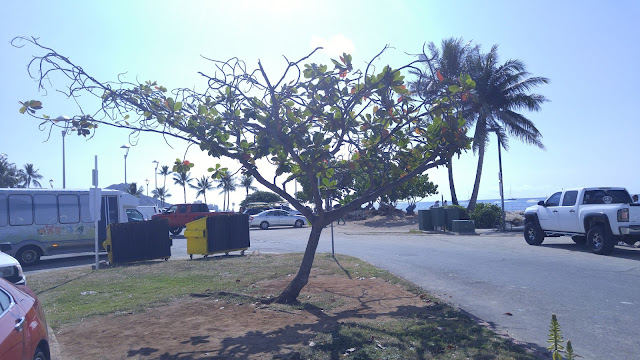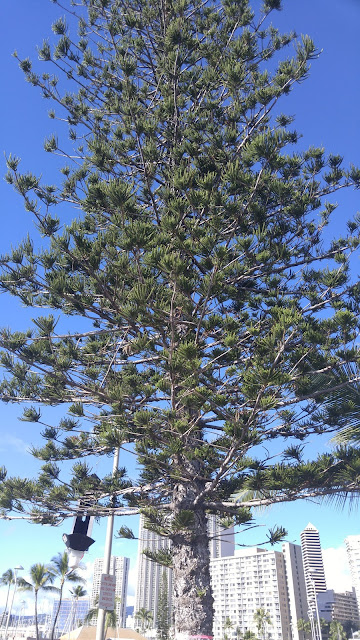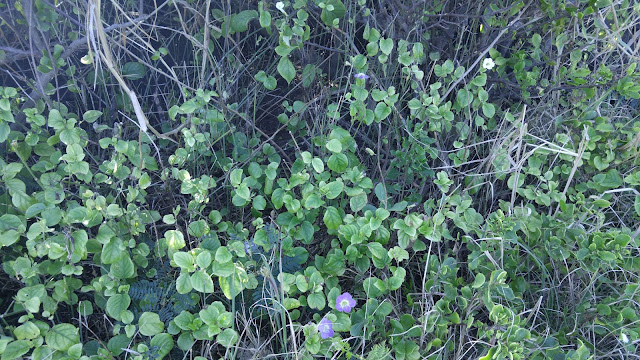Introductions
Hello! I am a student at the University of Hawai'i at Manoa who just recently arrived in Hawai'i for the first time. Throughout my time here, I plan on exploring all the nooks and crannies of the island so I can learn as much about this place as possible. However, beaches are an attraction that bring a lot of visitors from around the world to Oahu. As a natural history student, I'm interested in the species assemblage at each of Oahu's beaches around the island. Some questions I'll ask include: what species are common around the island? What is the assemblage of species at "tourist-y" beaches like Waikiki? How does the assemblage differ between beaches? What kinds of habitats or niches do the beaches provide? All these and more will be explored with plenty of beautiful pictures along the way. Generally, I will provide an overview of the beach I am visiting and then go through images of the flora and fauna that I encounter at that location. At the end of each post I'll wrap things up with a summary and comparisons to previous locations. I will use the
Hawaiian Native Plant Genera page provided by the UH Manoa botany department and the book
A Guide to Hawai'i's Coastal Plants by Michael Walther to identify plants I encounter. For animals, I'll be using
The Ecotravellers' Wildlife Guide: Hawaii by Les Beletsky.
Ka'ena Point and the North Shore
My first beach visit on Oahu wasn't technically a visit to the beach. Ka'ena point is the location of a major conservation project to preserve native Hawaiian species. The point is at Northwestern end of the island of Oahu. A fence separates the point from the rest of the island to keep predators and invasive species from entering. More about the project can be found on the Ka'ena Point
official page.
I started my day about an hour's hike away from Ka'ena along the north shore. The waves here can get to be almost 40 ft. tall during this time of year. On this trip, they were around 15-20 ft.
As you make your way towards Ka'ena, you see that there are many low lying plants that grow along the coastline. These low lying plants make up the majority of the flora found along this part of the north shore.
The Chinese Violet (
Asystasia gangetica) is a garden plant that is spreading rapidly in Hawai'i. These shrubby plants can smother other vegetation such as the 'Ala'ala wai nui (
Plectranthus parviflorus) in the lower right corner.
The 'Ilima (
Sida fallax) is the official flower of 'Oahu. These plants are still fairly common around the island and I saw several near Ka'ena. Pictured is the plant growing among some Pili grass (
Heteropogon contortus).

The Pa'uohi'iaka (
Jacquemontia ovalifolia subsp. sandwicensis) is common around the Hawaiian islands. This species of plant can be found outside of Hawai'i, but the pictured subspecies is endemic. The invasive Australian Saltbrush (
Altriplex semibaccata)
can be seen in the lower half of this image.
This guy was the first bird I spotted on the trail. I wasn't able to get too close but my best guess on this one is the Pacific Golden-Plover or Kolea (
Pluvialis fulva). They can be found all over the island in natural and developed areas. Swolle Fingergrasses (
Chloris barbata) can be seen on either side of the trail here. They are characterized by the brown tufts that give them their name.
Red-Crested Cardinals (Paroaria coronata) are a common sight in developed areas of the island, but I was surprised to see them so close to the coast. Although, this area is dry enough to accommodate them.
The flowering plant below on the left is the Koali 'awa (
Ipomoea indica) that is characterized by its light purple-white flowers and heart-shaped leaves. To the lower right is another Chinese Violet plant. If you look closely you may also find the banana spider (
Argiope appensa) siting on her web.
The Naupaka (
Scaevola taccada) is a common shrub plant found around coastal areas of the Hawaiian islands. This plant can also be found on coastlines throughout the Tropical Pacific and Indian oceans.
Naio (
Myoporum sandwicense) is an endemic tree that can grow between 3 to 35 ft. This plant is sometimes referred to as "Bastard Sandalwood" because it makes a cheap replacement for sandalwood when stocks are low.
The white flowers seen below belong to the Koa haole (
Leucaena leuocephala), which is an invasive plant. It has high drought tolerance and forms dense thickets. Not pictured are the large green or brown seed pods that also characterize this plant.
This beach is called "hidden beach" if you look for it on google maps. It's fairly small and rocky so it may not be the best idea to go too far out in the water, but it was a nice place to stop and hang out.
Slugs are a major issue in Hawaii as they ravage garden plants and may carry rat lungworm. Below is the Cuban slug (
Veronicella cubensis) found on the trail to Ka'ena along the North Shore.
More info.
There were several 'akoko plants that were both outside the fence and inside the fence at Ka'ena. Some of them looked like the one pictured below with many of its leaves gone. This particular plant (
Euphorbia celastroides var. kaenana) can only be found at Ka'ena point. This variety is currently endangered.
Coastal 'Ohai
(
Sesbania tomentosa) is characterized by the reddish flower seen hiding behind some leaves below. This species is currently endangered on the Hawaiian islands.
This bird is the main attraction of Ka'ena Point. The Laysan Albatross or Moli (
Phoebastria immutabilis) can only be found in the Pacific. A population of these birds nest in Hawai'i at Ka'ena point during the winter months. The enclosure was mainly built to protect these birds from predators such as the Polynesian rat (Kepler, 1967).
Some more Naupaka found within the enclosure with flowers in bloom. The half-circle morphology of these flowers is the basis of a Hawaiian legend that the beach Naupaka and the mountain Naupaka were once lovers who were separated by the god Pele due to jealousy. The lovers were transformed into plants to spare them from Pele's wrath. It is said the lovers can be reunited if a flower from the coastal variety is paired with a flower from the mountain variety.
The Hawaiian archipelago is the only place that the Hawaiian monk seal or 'Ilio-holo-i-ka-uana (
Monachus schauinslandi) can be found. They generally live near the secluded islets and atolls of the Northwest Hawaiian Islands, but they can be found on the main islands, Kauai to the big island, as well (Beletsky, 2000). Ka'ena is a great place to go to look for them. Be aware that the species is currently endangered so give them plenty of space if you see them.
Northern Mockingbirds (
Mimus polyglottos) such as the one pictured below could be seen perched atop branches within the fence of Ka'ena. They can generally be found in dry forest or dry scrub habitats.
The shrub pictured here is the Nehe (
Lipochaeta integrifolia), an endemic flowering plant. The pictured spider is a "Hawaiian Garden Spider" or "Banana Spider" (
Argiope appensa). These spiders were introduced to Hawai'i and the females are larger than the males. The pictured spider is one of them.
ID Source.
Summary:
Rating: 5/5
The Hike to Ka'ena is fairly easy coming from the Northern side. From the parking area to the tip is about an hour's hike. The best time to go is between December and February when the Laysan Albatross are nesting. The "hidden beach" is the closest beach area to the Ka'ena and is perfect for a shallow dip or a rest. The waves are not as strong at this small alcove beach as compared to the surrounding beach areas on the North Shore, but they can still get pretty rough. I got to see many native/endemic plants and animals, but there were also several invasive species as well. The enclosure has been helping to bring the Laysan Albatross population back up, but as far as plants go there was a mix of invasive and native species both outside and within the enclosure. This location is great for seeing native and endemic species. The trail is accessible to everyone and the hike is fairly easy with places to rest along the way.
Book and Journal citations:
Beletsky, L. (2000) The Ecotravellers' Wildlife Guide: Hawaii. London, UK: Academic Press.
Kepler, C. B.. (1967). Polynesian Rat Predation on Nesting Laysan Albatrosses and Other Pacific Seabirds. The Auk, 84(3), 426–430. http://doi.org/10.2307/4083097
Walther, M. (2004) A Guide to Hawai'i's Coastal Plants. Honolulu, HI: Mutual Publishing, LLC.
USDA, APHIS. 2010. Tropical Terrestrial Gastropods: Pest Information. Emergency and Domestic Programs: Chapter 2 and 6. 5/2011‐1 Cowie, R.H. 1990. Non‐indigenous land and freshwater molluscs in the islands of the Pacific: conservation impacts and threats; Hawaii Biological Survey Contribution No. 1990‐010.
Web citations:
"Hawaiian Garden Spider Insect Information." Hawaiian Garden Spider. Www.InsectIdentification.org, 18 July 2014. Web. 07 Mar. 2016.
"Jump Start For Index Page." Hawaiian Native Plants, UH Botany. Gerald D. Carr, 29 Mar. 2006. Web. 17 Feb. 2016.
"KA‘ENA POINT ECOSYSTEM RESTORATION PROJECT." Hawaii.gov. State of Hawaii, Feb. 2009. Web. 17 Feb. 2016.



































